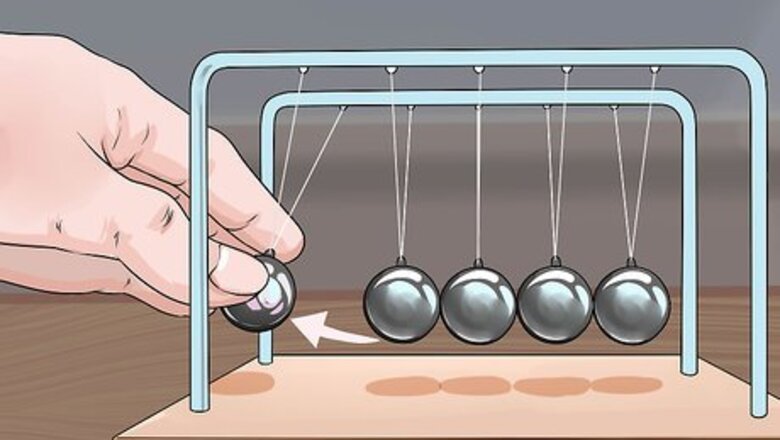
views
Using the Newton’s Cradle
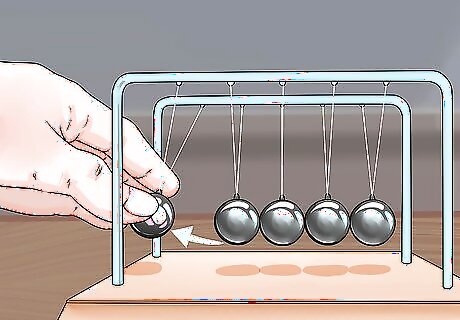
Start by pulling back 1 ball. The further you pull back the ball, the more potential energy you will give it. This potential energy is created because you have moved the ball to a higher point, and now it has the potential to fall when released.
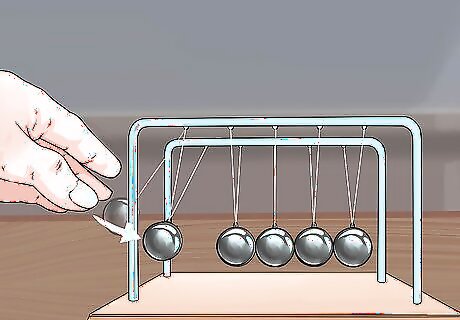
Release the ball. This will allow the ball to fall, converting its potential energy to kinetic energy. The other important thing that happens is that the ball gains momentum. This momentum, as well as the energy, cannot simply disappear when the ball reaches the bottom. It must be conserved.

Watch as the energy and momentum transfer from the first ball to the last ball. Ultimately, this is the entertaining part of the Newton’s Cradle. When the first ball reaches the bottom and strikes the second ball, it stops. The momentum and kinetic energy that the ball gained during its fall is transferred through the middle balls and passed along to the last ball, which swings out away from the other balls.

Observe the cycle you have created. Momentum and energy will continue to be passed from the ball on one side of the cradle to a ball on the other end. Gradually, the energy and momentum will be dissipated. This will be evident by the balls’ max height being a bit lower each time than the time before. Once the last ball swings up and away from the others, gravity will not allow it to simply stay there. It will reach a peak point that is nearly as high as the starting height of the first ball. At this point, the ball will have converted all of its kinetic energy to potential energy. The fall back down converts the potential energy back into kinetic energy and momentum, then transfers these back through the middle balls into the first. Now, the first ball swings up again and the cycle continues for a long time.
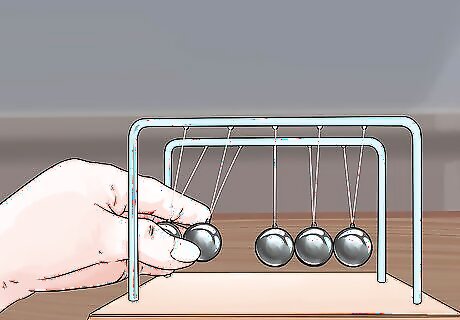
Tweak the experiment by pulling back 2 balls. Momentum is equal to the mass that is moving times the velocity (not speed) that it is moving. Since this momentum must be conserved, the 2 balls at the end will be pushed away from the center ball instead of just 1. Other than 2 balls on each end moving, the cycle will continue just as if you had pulled back 1 ball.

Have fun experimenting. Try doing 3 or 4 balls and see what happens. You can also pull the ball(s) back more or less to tweak the amount of energy they start with. If you let it, this can entertain you for quite a while. Hint: The number of balls you pull back will be the same number that swings out on the other end.
Understanding (or Teaching) How the Newton’s Cradle Works
Note how potential and kinetic energy differ. Potential energy is stored and results from the position of an object or an arrangement of the object’s parts. Potential energy can be converted to kinetic energy. Kinetic energy comes from the motion of an object.
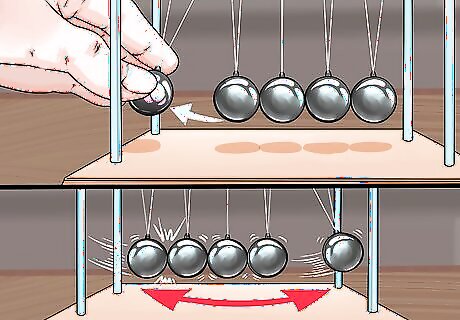
Show that energy must be conserved using the cradle. The inability to create or destroy energy is a central theme of thermodynamics. This means that whatever energy you introduce to the system (by raising the first ball) must be conserved in the system. This means that the energy must continue to move through the system even after the first ball reaches the bottom and stops. You can see this happen when the last ball goes up to nearly the same height as the first.
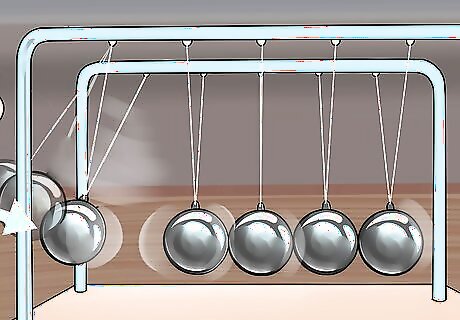
Observe that momentum is also conserved in the cradle. Not only is the energy of the system conserved, but the momentum is also conserved. This is why the same number of balls swings out on each side at the same speed. Momentum is nothing more than some mass times the velocity at which it is moving. In the case of the cradle, the momentum can be found by multiplying the velocity at which the ball falls from its highest point by the mass of the ball.

Think about why the last ball does not continue its upward path. It would seem, since momentum is conserved, that once the last ball is launched away from the others, it would continue traveling up and away. Theoretically, this would happen if it weren’t for gravity. Gravity acts upon the ball as it travels upward, slowing it. As this happens, kinetic energy is converted back to potential energy and momentum is reduced. Once the ball reaches its peak height, gravity flips roles and converts the potential energy into kinetic energy and momentum, but in the downward direction instead of the upward direction.

Be aware that the cradle will stop. In an ideal system the energy and momentum would be passed back and forth from one side of the cradle to the other in an endless game of tag. However, the real world is not what physics considers an “ideal” system. Friction is a force that slows the motion of the balls. In this case, the impeding force of friction comes from a combination of factors. There is a small amount of air resistance as the balls are traveling up and down. There will also be some energy lost to heat when the balls collide with one another. Even the sound you hear is a vibration that slowly saps energy from the cradle.
Using the Principles Behind Newton’s Cradle Elsewhere

Bounce a bouncy ball. Bouncy balls are made of highly elastic materials which means, when they collide with a surface, they do not lose much energy. Instead, the collision deforms the ball (by making it compress and changing the kinetic energy to potential energy) and then the ball springs (or bounces) back into shape. The act of bouncing back into shape converts the newfound potential energy back into kinetic energy, except now the momentum is in the opposite direction. This is much like how gravity converts the kinetic energy of balls in the cradle to potential energy, and how the balls pass along the kinetic energy and momentum through highly elastic collisions. When the ball is going up, gravity acts on it exactly the same way as the balls in the Newton’s Cradle.

Play a game of pool. Pool balls, like the balls on the Newton’s Cradle, are hard and contact each other in a highly elastic way. Energy is put into the system by hitting the cue ball with the cue. That ball travels until it hits another ball and stops. The momentum from the cue ball is conserved by passing it along to the target ball, and in turn moving the target ball down the table.
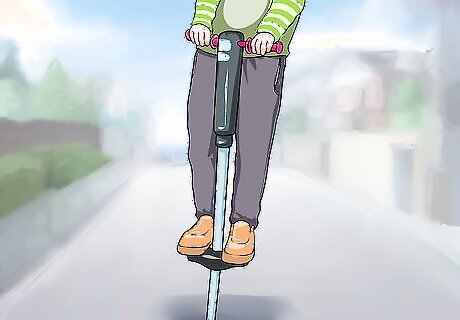
Use a pogo stick. This is very interactive way to get a feel for these principles. The pogo stick operates the same way as a bouncy ball more or less. The biggest difference is that you are on the stick, so you can literally feel some of these forces at work!




















Comments
0 comment